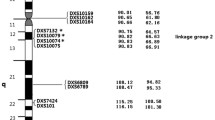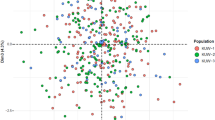Abstract
Polymorphisms located on the X chromosome are being increasingly used in forensic studies. However, they have not been studied as extensively as the autosomal and Y-linked polymorphisms. Therefore, we planned to study the population genetics of two sets of X-linked markers, including short-tandem repeats (STRs) and single nucleotide polymorphisms (SNPs), and particularly analyze the differences at the microgeographical level. Six X-linked STRs (DXS 9895, DXS 7132, DXS 9898, DXS 6789, GATA 172D05, and DXS 7130) and ten SNPs (rs1229078, rs1544545, rs4442270, rs1874111, rs5968332, rs1166756, rs12849634, rs5932595, rs203648, and rs611711) were studied in two population samples from Cantabria, northern Spain, a mixed coastal population and a relatively isolated small population in the Pas valley. There were statistically significant differences in allelic frequencies of the six STRs studied between both populations. On the other hand, only one out of ten SNPs studied showed between-population differences. Overall Fst values were 0.4–2.9% and 1.8–2.2% for the STRs and the SNPs, respectively. The overall power of discrimination for female samples was higher than 99.99% for both groups of markers. Therefore, these sets of X-linked STRs and SNPs seem to be potentially useful in forensic genetics, but care should be taken when interpreting results from cases that originate from small and relatively isolated populations.
Similar content being viewed by others
References
Asamura H, Sakai H, Kobayashi K, Ota M, Fukushima H (2006) MiniX-STR multiplex system population study in Japan and application to degraded DNA analysis. Int J Legal Med 120:174–181
Asamura H, Sakai H, Ota M, Fukushima H (2006) Japanese population data for eight X-STR loci using two new quadruplex systems. Int J Legal Med 120:303–309
Benjamini Y, Drai D, Elmer G, Kafkafi N, Golani I (2001) Controlling the false discovery rate in behavior genetics research. Behav Brain Res 125:279–284
Benjamini Y, Yekutieli D (2005) Quantitative trait Loci analysis using the false discovery rate. Genetics 171:783–790
Bini C, Ceccardi S, Ferri G et al (2005) Development of a heptaplex PCR system to analyse X-chromosome STR loci from five Italian population samples. A collaborative study. Forensic Sci Int 153:231–236
Budowle B, Shea B, Niezgoda S, Chakraborty R (2001) CODIS STR loci from 41 sample populations. J Forensic Sci 46:453–489
Carvalho-Silva DR, Pena SD (2000) Molecular characterization and population study of an X chromosome homolog of the Y-linked microsatellite DYS391. Gene 247:233–240
Desmarais D, Zhong Y, Chakraborty R, Perreault C, Busque L (1998) Development of a highly polymorphic STR marker for identity testing purposes at the human androgen receptor gene (HUMARA). J Forensic Sci 43:1046–1049
Edelman J, Hering S, Michael M et al (2001) 16 X-chromosome STR loci frequency data from a German population. Forensic Sci Int 124:215–218
Edelman J, Szibor R (2003) The X-linked STRs DXS7130 and DXS6803. Forensic Sci Int 136:73–75
Freeman S (1979) The Pasiegos. Chicago University Press, Chicago
Henke L, Aaspollu A, Biondo R, Budowle B, Drobnic K, van Eede PHeal (2003) Evaluation of the STR typing kit Powerplex 16 with respect to technical performance and population genetics: a multicenter study. In: Brinkmann B, Carracedo A (eds) Evaluation of the STR typing kit Powerplex 16 with respect to technical performance and population genetics: a multicenter study. Elsevier, Amsterdam, pp 789–794
Kaessmann H, Zollner S, Gustafsson AC et al (2002) Extensive linkage disequilibrium in small human populations in Eurasia. Am J Hum Genet 70:673–685
Laan M, Wiebe V, Khusnutdinova E, Remm M, Paabo S (2005) X-chromosome as a marker for population history: Linkage disequilibrium and haplotype study in Eurasian populations. Eur J Hum Genet 13:452–462
Moure A, Suárez M (1995) De la Montaña a Cantabria. La construcción de una comunidad autónoma. Publicaciones de la Universidad de Cantabria, Santander
Poetsch M, Petersmann H, Repenning A, Lignitz E (2005) Development of two pentaplex systems with X-chromosomal STR loci and their allele frequencies in a northeast German population. Forensic Sci Int 155:71–76
Poetsch M, Sabule A, Petersmann H, Volksone V, Lignitz E (2006) Population data of 10 X-chromosomal loci in Latvia. Forensic Sci Int 157:206–209
Robino C, Giolitti A, Gino S, Torre C (2006) Development of two multiplex PCR systems for the analysis of 12 X-chromosomal STR loci in a northwestern Italian population sample. Int J Legal Med 120:315–318
Ross MT, Bentley DR, Tyler-Smith C (2006) The sequences of the human sex chromosomes. Curr Opin Genet Develop 16:213–218
Schaffner SF (2004) The X chromosome in population genetics. Nat Rev Genet 5:43–51
Scozzari R, Cruciani F, Malaspina P et al (1997) Differential structuring of human populations for homologous X and Y microsatellite loci. Am J Hum Genet 61:719–733
Service S, Deyoung J, Karayuorgou M, Roos JL, Pretorious H, Bedoya Geal (2006) Magnitude and distribution of linkage disequilibrium in population isolates and implications for genome-wide association studies. Nat Genet 38:556–560
Sobrino B, Brion M, Carracedo A (2005) SNPs in forensic genetics: a review on SNP typing methodologies. Forensic Sci Int 154:181–194
Szibor R, Edelman J, Hering S et al (2003) Cell line DNA typing in forensic genetics—the necessity of reliable standards. Forensic Sci Int 138:37–43
Szibor R, Hering S, Kuhlisch E et al (2005) Haplotyping of STR cluster DXS6801–DXS6809–DXS6789 on Xq21 provides a powerful tool for kinship testing. Int J Legal Med 119:363–369
Szibor R, Krawczak M, Hering S, Edelman J, Kuhlisch E, Krause D (2003) Use of X-linked markers for forensic purposes. Int J Legal Med 117:67–74
Szibor R, Lautsch S, Plate I, Beck N (2000) Population data on the X chromosome short tandem repeat locus HumHPRTB in two regions of Germany. J Forensic Sci 45:231–233
Weir BS (1996) Genetic data analysis II. Sinauer, Sunderland
Zarrabeitia MT, Alonso A, Martin J et al (2006) Study of six X-linked tetranucleotide microsatellites: population data from five Spanish regions. Int J Legal Med 120:147–150
Zarrabeitia MT, Amigo T, Sañudo C, Martinez MA, Riancho JA (2002) Sequence structure and population data of two novel X-linked markers: DXS7423 and DXS8377. Int J Legal Med 116:368–371
Zarrabeitia MT, Amigo T, Sañudo C, Zarrabeitia A, González-Lamuño D, Riancho JA (2002) A new pentaplex system to study short tandem repeat markers of forensic interest on X chromosome. Forensic Sci Int 129:85–89
Zarrabeitia MT, Riancho JA, Lareu MV, Leyva-Cobian F, Carracedo A (2003) Significance of micro-geographical population structure in forensic cases: a bayesian exploration. Int J Legal Med 117:302–305
Author information
Authors and Affiliations
Corresponding author
Electronic supplementary material
Below are the links to the electronic supplementary material.
Table 1E
Population data of X-linked STRs in triplex 1 (DOC 32 kb)
Table 2E
Population data of X-linked STRs in triplex 2 (DOC 37 kb)
Table 3E
Population data of X-linked SNPs (DOC 37 kb)
Fig. 1
Approximate location of the loci studied on the X chromosome (DOC 33 kb)
Rights and permissions
About this article
Cite this article
Zarrabeitia, M.T., Mijares, V. & Riancho, J.A. Forensic efficiency of microsatellites and single nucleotide polymorphisms on the X chromosome. Int J Legal Med 121, 433–437 (2007). https://doi.org/10.1007/s00414-007-0169-3
Received:
Accepted:
Published:
Issue Date:
DOI: https://doi.org/10.1007/s00414-007-0169-3




